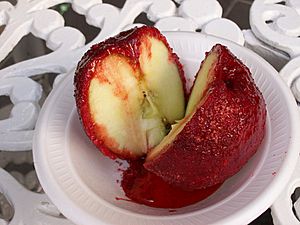Chamoy facts for kids
Chamoy is a super popular and yummy sauce or condiment from Mexican cuisine. It's made from fruit that has been pickled, which means it's preserved in a salty or sour liquid. Chamoy can be thin like a liquid or thick like a paste. It usually tastes salty, sweet, sour, and a little spicy from chiles!
Contents
Where Did Chamoy Come From?
The exact start of chamoy is a bit of a mystery. But there are some cool ideas about its history!
Chinese Roots?
One idea is that the word "chamoy" might come from a Cantonese word, see mui. This word refers to a type of Chinese snack called crack seed. Some people think that Chinese travelers brought this idea with them to Mexico a long time ago.
Japanese Connection?
Another idea is that chamoy is a Mexican version of a Japanese food called umeboshi. This is a pickled ume fruit. Instead of ume, Mexican chamoy often uses fruits like apricot, plum, or mango. A Japanese person named Teikichi Iwadare, who moved to Mexico, made umeboshi with apricots in the 1950s and called it "chamoy."
How is Chamoy Made?
Making chamoy starts by pickling fruit. This is similar to how umeboshi is made.
- First, fruit is packed in dry salt or a salty water mix called a brine.
- This process pulls out the natural water from the fruit.
- When the fruit is dry enough, it's separated from the salty liquid. This dried fruit is sometimes sold as a snack called saladitos, which means 'little salty things'.
- The salty liquid left over is then spiced up with chile powder. This liquid becomes chamoy!
- Sometimes, this liquid is cooked down or mixed with fruit puree to make it thicker.
Because different fruits and brines are used, chamoy can taste very different. Most kinds are savory and spicy from the chile powder, and salty from the brine. Depending on how much vinegar is used, it can also be sour or sweet.
How Do People Use Chamoy?
Chamoy is used in many fun ways in Mexico and parts of the American southwest.
Sauce and Dip
Thinner chamoy is often sold in bottles, just like hot sauce. Because it has a mix of salt, sweetness, and spice, people use it on all sorts of foods. You can put it on fresh fruit, juices, potato chips, or even nuts! It's also a key ingredient in a popular street food called "tostilocos."
Thicker chamoy, which is more like a paste, sometimes comes in small jars. This kind is great for dipping vegetables or firmer fruits. These jars are often sold next to other popular Mexican candies made from mango, tamarind, and watermelon. These candies are also often made in a "salty and spicy" style.
Frozen Treats
Chamoy is also a super popular flavor for frozen desserts!
- It's used in sorbet or raspados, which are like snow cones. This creates a unique mix of sweet, salty, spicy, and cold flavors.
- Raspados made with chamoy are often called chamoyadas.
- Paletas, which are Mexican ice pops, are also commonly offered with chamoy.
- Some favorite fruit flavors to combine with chamoy in raspados and paletas include pineapple, cucumber, lime, mango, orange, tangerine, tamarind, and watermelon.
Drinks
Sometimes, the popular Mexican beer mix called michelada is made with chamoy. It can be used instead of, or in addition to, the usual sauces in the drink.


